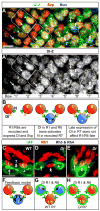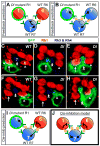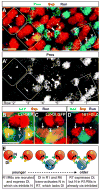cis-Inhibition of Notch by endogenous Delta biases the outcome of lateral inhibition
- PMID: 19631544
- PMCID: PMC2761761
- DOI: 10.1016/j.cub.2009.06.042
cis-Inhibition of Notch by endogenous Delta biases the outcome of lateral inhibition
Abstract
Lateral inhibition mediated by Delta/Notch (Dl/N) signaling is used throughout development to limit the number of initially equivalent cells that adopt a particular fate. Although adjacent cells express both Dl ligand and N receptor, signaling between them ultimately occurs in only one direction. Classically, this has been explained entirely by feedback: activated N can downregulate Dl, amplifying even slight asymmetries in the Dl or N activities of adjacent cells. Here, however, we present an example of lateral inhibition in which unidirectional signaling depends instead on Dl's ability to inhibit N within the same cell, a phenomenon known as cis-inhibition. By genetically manipulating individual R1/R6/R7 photoreceptor precursors in the Drosophila eye, we show that loss of Dl-mediated cis-inhibition reverses the direction of lateral signaling. Based on our finding that Dl in R1/R6s requires endocytosis to trans-activate but not to cis-inhibit N, we reexamine previously published data from other examples of lateral inhibition. We conclude that cis-inhibition generally influences the direction of Dl/N signaling and should therefore be included in standard models of lateral inhibition.
Figures




Comment in
-
Notch signalling: receptor cis-inhibition to achieve directionality.Curr Biol. 2009 Aug 25;19(16):R683-4. doi: 10.1016/j.cub.2009.07.025. Curr Biol. 2009. PMID: 19706274
Similar articles
-
Three distinct roles for notch in Drosophila R7 photoreceptor specification.PLoS Biol. 2011 Aug;9(8):e1001132. doi: 10.1371/journal.pbio.1001132. Epub 2011 Aug 23. PLoS Biol. 2011. PMID: 21886484 Free PMC article.
-
Notch signalling: receptor cis-inhibition to achieve directionality.Curr Biol. 2009 Aug 25;19(16):R683-4. doi: 10.1016/j.cub.2009.07.025. Curr Biol. 2009. PMID: 19706274
-
The R8-photoreceptor equivalence group in Drosophila: fate choice precedes regulated Delta transcription and is independent of Notch gene dose.Mech Dev. 1998 Jun;74(1-2):3-14. doi: 10.1016/s0925-4773(98)00054-9. Mech Dev. 1998. PMID: 9651468
-
NOTCH and the patterning of ommatidial founder cells in the developing Drosophila eye.Results Probl Cell Differ. 2002;37:35-58. doi: 10.1007/978-3-540-45398-7_4. Results Probl Cell Differ. 2002. PMID: 25707068 Review. No abstract available.
-
Delta-notch signaling and Drosophila cell fate choice.Dev Biol. 1994 Dec;166(2):415-30. doi: 10.1006/dbio.1994.1326. Dev Biol. 1994. PMID: 7813766 Review.
Cited by
-
Notching on Cancer's Door: Notch Signaling in Brain Tumors.Front Oncol. 2015 Jan 5;4:341. doi: 10.3389/fonc.2014.00341. eCollection 2014. Front Oncol. 2015. PMID: 25601901 Free PMC article. Review.
-
Three distinct roles for notch in Drosophila R7 photoreceptor specification.PLoS Biol. 2011 Aug;9(8):e1001132. doi: 10.1371/journal.pbio.1001132. Epub 2011 Aug 23. PLoS Biol. 2011. PMID: 21886484 Free PMC article.
-
Not(ch) just development: Notch signalling in the adult brain.Nat Rev Neurosci. 2011 May;12(5):269-83. doi: 10.1038/nrn3024. Nat Rev Neurosci. 2011. PMID: 21505516 Free PMC article. Review.
-
Role of Notch Signaling Pathway in Glioblastoma Pathogenesis.Cancers (Basel). 2019 Mar 1;11(3):292. doi: 10.3390/cancers11030292. Cancers (Basel). 2019. PMID: 30832246 Free PMC article. Review.
-
Extramacrochaetae regulates Notch signaling in the Drosophila eye through non-apoptotic caspase activity.bioRxiv [Preprint]. 2024 Oct 28:2023.10.04.560841. doi: 10.1101/2023.10.04.560841. bioRxiv. 2024. Update in: Elife. 2024 Nov 20;12:RP91988. doi: 10.7554/eLife.91988. PMID: 39131389 Free PMC article. Updated. Preprint.
References
-
- Artavanis-Tsakonas S, Rand MD, Lake RJ. Notch signaling: cell fate control and signal integration in development. Science. 1999;284:770–776. - PubMed
-
- Baker NE. Notch signaling in the nervous system. Pieces still missing from the puzzle. Bioessays. 2000;22:264–273. - PubMed
-
- Bray SJ. Notch signalling: a simple pathway becomes complex. Nat Rev Mol Cell Biol. 2006;7:678–689. - PubMed
-
- Heitzler P, Simpson P. The choice of cell fate in the epidermis of Drosophila. Cell. 1991;64:1083–1092. - PubMed
-
- Wilkinson HA, Fitzgerald K, Greenwald I. Reciprocal changes in expression of the receptor lin-12 and its ligand lag-2 prior to commitment in a C. elegans cell fate decision. Cell. 1994;79:1187–1198. - PubMed
Publication types
MeSH terms
Substances
Grants and funding
LinkOut - more resources
Full Text Sources
Other Literature Sources
Molecular Biology Databases

